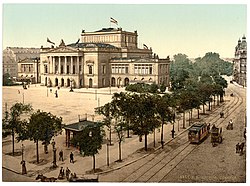Leipzig
- REDIRECT Template:Infobox German place
Leipzig (Upper Saxon: Leibzsch or Leibz'sch) is the biggest city in the state of Saxony (eastern Germany). When Germany was divided into East and West Germany, Leipzig was one of the three biggest industrial cities in the East Germany.
Leipzig occupies 297.62 km2 (114.9 sq mi) and is still an industrial city. 510,651 people are living in Leipzig as of 29 February 2008.
History
Its Latin name is Lipsia and the German name "Leipzig" came from this name. Leipzig has a long history. Its name was first recorded as Leipzig Castle (Leipziger Burg) in 1015, and the official founding of the city occurred later in 1165. It was an economic center of Medieval Germany, famous with its market (Leipziger Messe).
In 1409, Leipzig University was started. Theology was its major faculty. In 1519, Martin Luther had a discussion in Leipzig against Johann Eck. Reformation came to Leipzig in 1539 and the city people became Lutheran.
It is famous for St. Thomas Church, where Johann Sebastian Bach worked as music director (Kantor) from 1723 until his death in 1750.
In 1813, near Leipzig, the Battle of Leipzig was fought between the French Army, led by Napoleon Bonaparte, and the victorious Allied armies of Austria, Prussia and Russia.
In 1839, the railway between Dresden and Leipzig was opened. It was the first long-distance railway in Germany.
As a result of industrialization, the number of people living in Leipzig grew during the 19th century. Before World War II, there were about 750,000 people in Leipzig.
After the war, Leipzig belonged to the part of Germany that was occupied by the Soviet Union and later to East Germany.
In 1989, the Monday Demonstrations took place in Leipzig. Every Monday after a Christian Mass in the Nikolaikirche, people in Leipzig demonstrated for the freedom to travel and for democracy. These demonstrations became bigger and bigger and reached their peak on 23 October when 320,000 people came. The demonstrations are one of the things that led to the end of the East German communist dictatorship.
Today, Leipzig is still known as a city of fairs, media and university, but the city is less important than it was before World War II.
Economy
Before World War II, Leipzig was a famous center of commerce (Leipzig exhibition) and industry. Now, there are big companies in Leipzig like Porsche, BMW, Siemens and DHL, as well as the Leipzig Airport.
Population
With almost 511,000 people, Leipzig city proper is the 12th biggest city in Germany and the 2nd biggest in what was East Germany (DDR), smaller than East Berlin and bigger than Dresden. Leipzig urban has 567,000 people. The total population of Leipzig metropolitan area is 1,389,000.
Geography
Leipzig, Chemnitz, Dresden, Halle, and Zwickau form an area called the Saxon Triangle, which has about 3,500,000 people.
Miscellaneous
Leipzig has a university where famous people studied (e.g. Johann Wolfgang von Goethe, Edvard Grieg, Erich Kästner, Gottfried Wilhelm Leibniz, Gotthold Ephraim Lessing, Angela Merkel, Friedrich Nietzsche, Robert Schumann and Richard Wagner.) The Leipzig Hauptbahnhof (Central Station) is the biggest terminal station in Europe. It sees about 150,000 passengers each day. It is 293 meters wide.
Sister cities
 Addis Ababa, Ethiopia, since 2004
Addis Ababa, Ethiopia, since 2004 Birmingham, UK, since 1992[1]
Birmingham, UK, since 1992[1] Bologna, Italy, since 1962, renewed in 1997
Bologna, Italy, since 1962, renewed in 1997 Brno, Czech Republic, since 1973, renewed in 1999[2]
Brno, Czech Republic, since 1973, renewed in 1999[2] Frankfurt am Main, Germany, since 1990[3]
Frankfurt am Main, Germany, since 1990[3] Hanover, Germany, since 1987[4]
Hanover, Germany, since 1987[4] Houston, United States, since 1993
Houston, United States, since 1993 Kyiv, Ukraine, since 1961, renewed in 1992
Kyiv, Ukraine, since 1961, renewed in 1992 Lyon, France, since 1981</[5]
Lyon, France, since 1981</[5] Nanjing, China, since 1988
Nanjing, China, since 1988 Plovdiv, Bulgaria, since 1975, renewed in 2007
Plovdiv, Bulgaria, since 1975, renewed in 2007 Thessaloniki, Greece, since 1984[6]
Thessaloniki, Greece, since 1984[6] Travnik, Bosnia and Herzegovina, since 2003
Travnik, Bosnia and Herzegovina, since 2003 Herzliya, Israel, since 2010
Herzliya, Israel, since 2010
Leipzig Media
The skyline of Leipzig seen from Cospudener See in the Neuseenland
The White Elster in the Plagwitz district of Leipzig
An impression of the Leipzig Riparian Forest (Leipziger Auenwald)
Battle of Leipzig, 1813
Augustusplatz with Leipzig Opera House, c. 1900
New Town Hall of Leipzig, built in 1905
References
- ↑ "Partner Cities". Birmingham City Council. Archived from the original on 2009-09-15. Retrieved 2009-07-17.
- ↑ "Brno - Partnerská města" (in Czech). City of Brno. Archived from the original on 2011-05-23. Retrieved 2009-07-17.
{{cite web}}: CS1 maint: unrecognized language (link) - ↑ "Frankfurt -Partner Cities". Stadt Frankfurt am Main. Archived from the original on 2015-10-16. Retrieved 2008-12-05.
- ↑ "Hanover - Twin Towns" (in German). Offizielles Portal der Landeshauptstadt und der Region Hannover in Zusammenarbeit mit hier.de. Archived from the original on 2011-07-24. Retrieved 2009-07-17.
{{cite web}}: CS1 maint: unrecognized language (link) - ↑ "Partner Cities of Lyon and Greater Lyon". © 2008 Mairie de Lyon. Archived from the original on 2009-07-19. Retrieved 2009-07-17.
- ↑ "Twinning Cities". City of Thessaloniki. Archived from the original on 2009-03-31. Retrieved 2009-07-07.
Other websites
| Wikimedia Commons has media related to Lua error in Module:Commons_link at line 62: attempt to index field 'wikibase' (a nil value).. |
- Lua error in Module:Official_website at line 90: attempt to index field 'wikibase' (a nil value). (in German)









